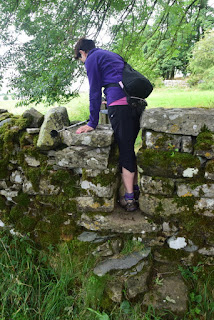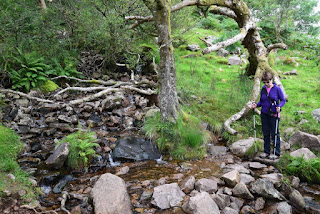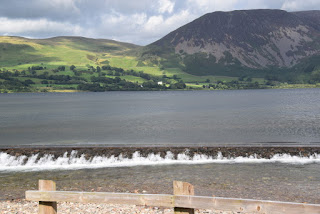Helen is quite keen on walking (2 or 3 times a week
stuff) and also loves the Lake District so it was a natural progression to
consider walks in the Lake district and what better than the challenge of walking
across England. The C2C goes from St Bees in the West (Irish sea) to Robin Hood
Bay in the East (North sea). Although some have done this as part of a race in
54 hours we opted for a more leisurely pace. We also decided to do half this
year (to Kirkby Stephen) and save the second half for a subsequent year. Eight
days seemed appropriate.
The walk is one that was detailed by Alfred Wainright
starting in 1952 in a wonderful little handbook.
We used a firm (Contours who booked the accommodation
and ferried our cases between B&Bs). Our first B&B (Abbey Farm House)
were prepared to park our car in return for a donation to their chosen charity.
We set off via the church and it’s 1160 Great West Door
to a statue of St Bega. This daughter of an Irish King (600 AD approx) fled in
a small coracle type boat when she refused to marry the man her father had
chosen. When she landed she wanted to found a nunnery and approached Lord
Egromont who laughingly promised her as much land as the snow covered the next
day. The next day was midsummer and it snowed.
It is not even certain that St Bega even existed but
snow on midsummer day is quite plausible!
Wainright wrote that you should transport a pebble to the East coast as well as dip your toe in the sea, so…
We even managed to cajole a passer by into taking a picture so you can see that I participated (well was at least at the start).
A dry but windy day with quite an upward hike to the lighthouse. The wind and sea spray prevented a viewing of the Isle of Man which is possible on a clear calm day.
As for the hike up it seemed significant at the time
but would soon pale into insignificance!
Towards the end of our first day this milestone reminded us of
how little we had travelled (albeit we had travelled a longer and more
circuitous route than the sign suggests).
Rather than give a daily blow by blow account I thought
grouping some highlights together would be more interesting. However, those with a map or a desire to link the blog with our schedule here is a summary:
Day 1 13.5 Kms St Bees tot Cleator Moor
Day 2 9 Kms Cleator Moor to Ennerdale Bridge
Day 3 23 Kms Ennerdale Bridge to Rosthwaite (B&B at Stonethwaite)
Day 4 14.5 Kms Rosthwaite to Grasmere
Day 5 13.5Kms Grasmere to Patterdale
Day 6 19 Kms Patterdale to Bampton
Day 7 18 Kms Bampton to Orton
Day 8 19 Kms Ortone to Kirkby Stephen
Days 3 to 6 included some substantial ascending and descending.
Most days we encountered stiles and streams. The stone stiles were robust affairs and tricky for the unwary as once your boot was in there was no turning back (around).
Day 1 13.5 Kms St Bees tot Cleator Moor
Day 2 9 Kms Cleator Moor to Ennerdale Bridge
Day 3 23 Kms Ennerdale Bridge to Rosthwaite (B&B at Stonethwaite)
Day 4 14.5 Kms Rosthwaite to Grasmere
Day 5 13.5Kms Grasmere to Patterdale
Day 6 19 Kms Patterdale to Bampton
Day 7 18 Kms Bampton to Orton
Day 8 19 Kms Ortone to Kirkby Stephen
Days 3 to 6 included some substantial ascending and descending.
Most days we encountered stiles and streams. The stone stiles were robust affairs and tricky for the unwary as once your boot was in there was no turning back (around).
Boots are the best footwear so you can just march through
streams, however if you opt for walking shoes you have to pick your way
carefully across stones.
Deeper streams required a pause and route planning
phase.
Mind you some of the paths required constant planning of
which stone to step on. The 3kms around Lake Ennerdale was particularly slow
(and at the end of the day painful).
There were some idyllic sections with paths of
small gravel – not that this made travel any quicker given the various plants
and other life that was in need of being photographed.
Animals were a constant photographic opportunity. These
small calves were tentatively curious.
As they grew so did their friskiness..
When fully formed and lying across the track walking together was mandatory. Who gave way; well the cows of course.
Some were happiest with this size of animal.
However, the dominant species was sheep – from the
curious
To the commanding – what are you doing on my patch?
Meanwhile this rock is just heavenly (reminded me of Baloo -
man this is really living)
To some that were in the pink
And then of course there is the well known “white sheep of
the family”.
Wherever we went we came across larks who in some
instances took off when we were less than a foot away – quite startling. These
two however seemed to have a need for a bit of fame (not that this blog can
promise that).
We also encountered quite a bit of industry from
various periods. There were several stone circles but the one near Orton was
the most obvious. These are from the Neolithic period (around 2500 BC). Some
have disappeared and all have been disrupted during ploughing over the years
but they are still something to contemplate.
Moving forward a few thousand years was Shap Abbey
founded in 1200 by some Premonstratensian canons. King Henry VIII suppressed
the abbey and evicted the canons back in 1540. Although some plundering
occurred it is now going through a significant conservation programme to stop
further deterioration.
The corner foundations comprised a large area of stones
to spread the load and resist outward pressure.
We also encountered a few lime kilns where
limestone was fired to produce lime for construction. These were largely built
in the 1800s but the technology goes back to Roman times.
More recently is the logging industry. However, it is
going through a difficult period as many Larch trees (the only deciduous
conifer native to Europe) now have a fungus and have to be felled so as to reduce
the extent of the disease (sounds familiar with Dutch Elm disease and the
removal of thousands of French plane trees – canal du midi). We saw thousands
of logs stacked along the track in the forest beyond Lake Ennerdale.
Lake Ennerdale was the start of day 3 and the first of
fours days with a significant climb. A small weir is used to funnel water into
a water treatment plant which other than for a couple of pipes was completely hidden
away. We were looking forward to a quick 3 Kms walk on the flat along the
length of the lake. Were we wrong; it was extremely stony and hard walking.
Not the sort of start we wanted to a 23 kms climbing day!
The most modern structure was on day 7
when we crossed the M6 near Shap. What a racket.
However, the small footbridge over did give rise to a
great and seemingly peaceful view (if you cut out the cement works!)
However, the last structure is perhaps the most
commanding – this is the Smardale Gill (now unused) Carlisle to Settle railway viaduct. Built in 1861 by Sir Thomas Bouch it is 90 ft high and has fourteen arches. It closed in 1962 when steel making ceased. It seems to
fit into the landscape.
The last two days were through rolling and well
signposted countryside.
Mind you the popularity of the route has inevitably started
to give rise to advertising signs – this one says “Bents Farm – Camping Barn”.
It would remiss not to spend sometime on the high point
of the walk. On day 6 we were greeted immediately by a quite steep climb up to
Angle Tarn. The weather was sunny and clear up to this point and then we
started to enter the misty low cloud.
Although we were some way up there was still quite a
bit more to go up to The Knott.
We eventually made it to the top (after a small
diversion off the wrong track – easily done with poor visibility and tracks
everywhere in the boggy conditions). Can we find our way? Of course we Cairn…
which marked Kidsty Pike which at 780 metres was the highest point of the walk.
What was spectacular was dropping down out of the mist
to sunny valleys below.
At the bottom we had to walk the 3 kms around Hawswater
reservoir which supplies Manchester.
We had a brief stop for a snack and comfort stop (which
as a Londoner only seemed appropriate).
There were waterfalls over many of the four climbing
days. This one was on the way up from Rosthwaite (Day 4) – perfect weather.
Beautiful waterfall near Hause Gap on the way up from
Grasmere.
Ruthwaite Lodge on the way down to Patterdale from
Hause Gap (Day 5 which started in Grasmere).
Mind you even the views from some of the B&Bs were great, made
especially so whilst lying in bed. This is Stonethwiate.
This one Patterdale.
The B&B in Patterdale was beautifully located
alongside Grisedale Beck.
Mind you the local was not a pub you wanted to fall out
of.
The Bampton B&B (ground floor – so no stairs and a
bath – brilliant) was just up the road from the pretty village of Bampton
Grange where the publican was wonderfully accommodating given our late arrival.
But perhaps the prettiest award goes to Orton. The B&B
and village were just sensational.
But of course there are the mountain views. (Day 3) saw us contemplating our first climb at Black Sail with the tiny (16 bed) Youth Hostel just ahead. Looking toward the climb up Loft Beck.
An hour or two later looking back to Ennerdale Water from the top of Loft
Beck.
Looking back up Grasmere Common
The wonderful different colours of the rolling Crosby
Ravensworth Fell East of Shap.
Some of the lane ways were gorgeous with their dappled light. This is shortly after leaving Rosthwaite.
and a bit more of Orton. We followed this brook
To the main bridge….
As a contrast to all the greenery we did see a brilliant sunset.
After 8 wonderful albeit tiring days we raised a toast
with a nice bottle of Pinot Grigio in Kirkby Stephen.
We did the 130 Kms at a leisurely pace - I am not sure we were the slowest on the
path after all we did pass others; it's just that they were either stopped for lunch or
walking the other way.
Will we complete the Eastern section? We need a bit of
a rest before deciding that one!
























































No comments:
Post a Comment